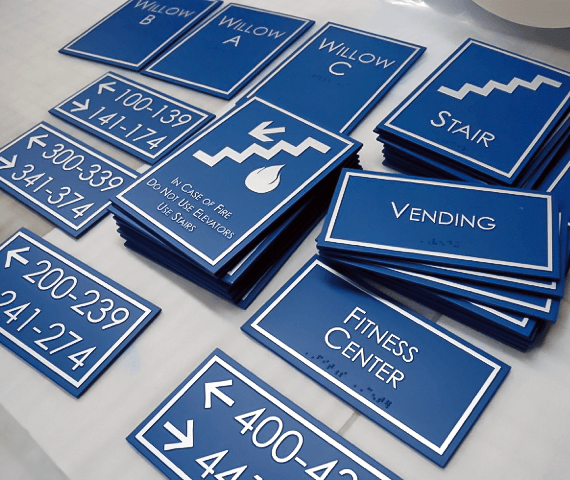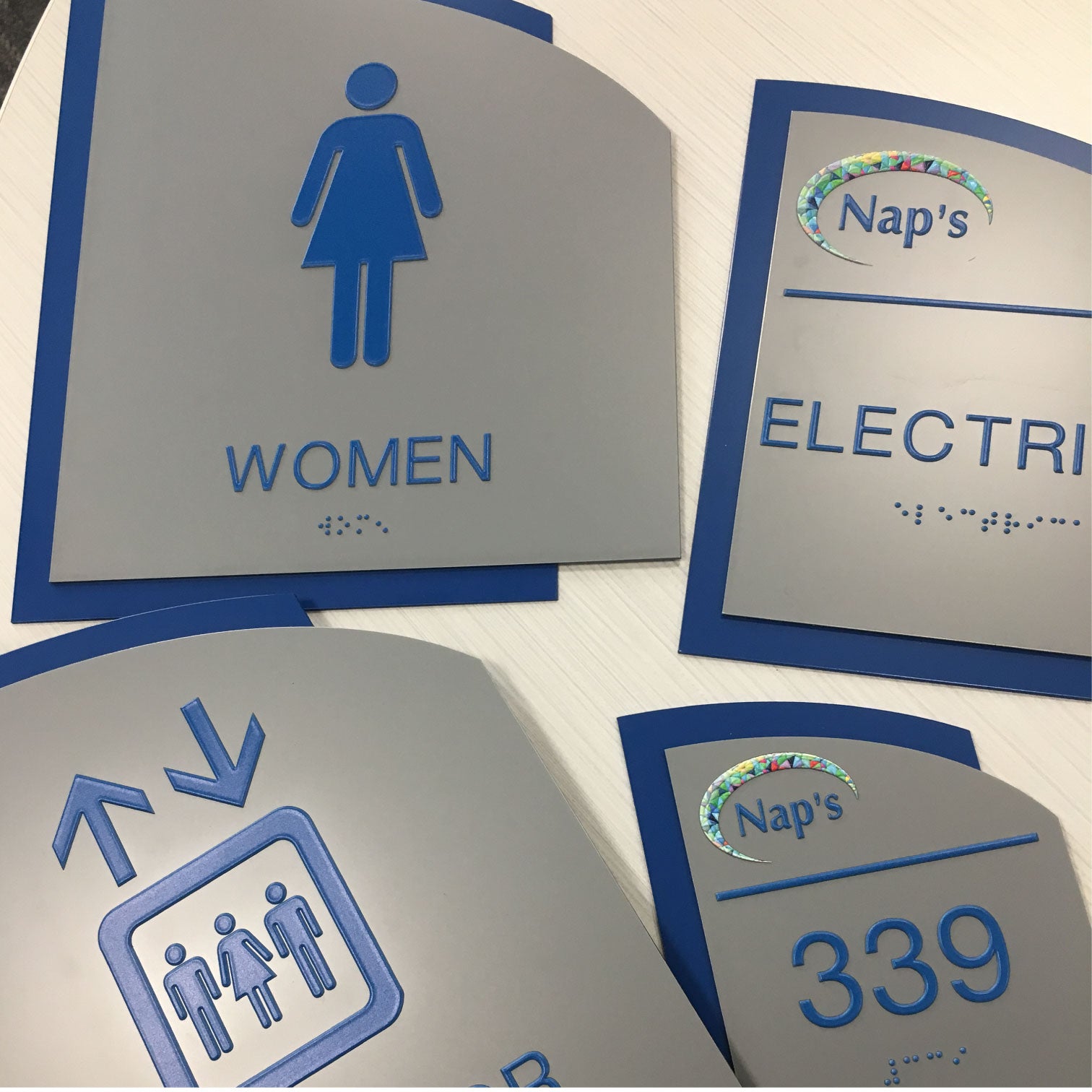The Effect of ADA Signs on Area Availability
Wiki Article
Exploring the Secret Features of ADA Signs for Boosted Availability
In the world of access, ADA indications serve as quiet yet powerful allies, guaranteeing that areas are inclusive and navigable for individuals with disabilities. By integrating Braille and responsive components, these indicators break barriers for the aesthetically impaired, while high-contrast shade schemes and understandable fonts cater to diverse visual needs.Importance of ADA Conformity
Making sure conformity with the Americans with Disabilities Act (ADA) is crucial for fostering inclusivity and equal accessibility in public spaces and workplaces. The ADA, passed in 1990, mandates that all public centers, companies, and transport services fit individuals with specials needs, ensuring they appreciate the exact same legal rights and chances as others. Compliance with ADA criteria not only satisfies legal commitments however likewise boosts an organization's track record by showing its dedication to diversity and inclusivity.One of the vital elements of ADA compliance is the application of easily accessible signs. ADA indications are made to make sure that individuals with specials needs can easily navigate via structures and spaces. These indicators must stick to specific guidelines pertaining to size, font style, shade contrast, and placement to guarantee visibility and readability for all. Properly executed ADA signs aids remove obstacles that individuals with disabilities commonly come across, thereby promoting their self-reliance and self-confidence (ADA Signs).
Moreover, sticking to ADA laws can minimize the danger of potential fines and legal repercussions. Organizations that fail to follow ADA standards may encounter lawsuits or penalties, which can be both damaging and economically challenging to their public picture. Hence, ADA conformity is important to cultivating a fair environment for every person.
Braille and Tactile Aspects
The unification of Braille and tactile elements into ADA signs personifies the principles of accessibility and inclusivity. It is typically positioned below the corresponding text on signage to make sure that people can access the details without aesthetic aid.Responsive components extend beyond Braille and consist of elevated characters and signs. These parts are designed to be noticeable by touch, enabling individuals to identify area numbers, bathrooms, departures, and other crucial areas. The ADA establishes details standards relating to the size, spacing, and placement of these responsive aspects to enhance readability and make certain uniformity across various settings.
High-Contrast Color Pattern
High-contrast color design play an essential function in boosting the presence and readability of ADA signage for individuals with visual problems. These systems are necessary as they optimize the distinction in light reflectance between message and history, guaranteeing that signs are easily discernible, also from a range. The Americans with Disabilities Act (ADA) mandates using certain color contrasts to accommodate those with limited vision, making it a vital Check This Out aspect of compliance.The effectiveness of high-contrast shades hinges on their ability to attract attention in numerous illumination conditions, consisting of dimly lit atmospheres and locations with glare. Normally, dark text on a light history or light message on a dark history is used to achieve optimum comparison. For circumstances, black message on a white or yellow history gives a stark visual difference that helps in fast recognition and understanding.

Legible Fonts and Text Size
When considering the design of ADA signs, the description selection of understandable fonts and ideal message size can not be overstated. The Americans with Disabilities Act (ADA) mandates that fonts need to be not italic and sans-serif, oblique, script, very attractive, or of unusual form.The dimension of the text additionally plays a pivotal function in accessibility. According to ADA guidelines, the minimum text height need to be 5/8 inch, and it needs to enhance proportionally with checking out distance. This is specifically crucial in public areas where signage needs to be reviewed quickly and accurately. Uniformity in message size contributes to a cohesive visual experience, helping individuals in navigating environments efficiently.
In addition, spacing between lines and letters is important to clarity. Appropriate spacing protects against personalities from showing up crowded, enhancing readability. By sticking to these criteria, developers can substantially boost access, making sure that signage serves its intended purpose for all individuals, despite their visual capabilities.
Efficient Positioning Methods
Strategic positioning of ADA signs is necessary for making the most of accessibility and guaranteeing compliance with legal requirements. Effectively positioned signs assist individuals with disabilities successfully, facilitating navigating in public spaces. Secret considerations consist of closeness, elevation, and presence. ADA guidelines stipulate that signs must be placed at an elevation in between 48 to 60 inches from the ground to guarantee they are within the line of view for both standing and seated individuals. This conventional elevation range is essential for inclusivity, enabling mobility device individuals and individuals of why not try these out differing elevations to accessibility information effortlessly.In addition, indications should be positioned adjacent to the lock side of doors to allow simple identification prior to access. Consistency in indication positioning throughout a center improves predictability, reducing complication and improving overall customer experience.

Final Thought
ADA signs play an essential role in advertising ease of access by incorporating attributes that resolve the demands of individuals with disabilities. Including Braille and tactile elements ensures critical information comes to the aesthetically impaired, while high-contrast color pattern and clear sans-serif font styles enhance visibility throughout numerous lights conditions. Reliable positioning methods, such as proper placing elevations and calculated areas, additionally facilitate navigation. These components jointly promote an inclusive atmosphere, underscoring the importance of ADA conformity in ensuring equal access for all.In the world of accessibility, ADA indications offer as quiet yet effective allies, making sure that spaces are navigable and inclusive for people with specials needs. The ADA, enacted in 1990, mandates that all public facilities, companies, and transportation solutions fit individuals with impairments, guaranteeing they enjoy the same legal rights and opportunities as others. ADA Signs. ADA indicators are designed to make certain that people with impairments can easily browse through buildings and spaces. ADA guidelines specify that signs need to be placed at a height in between 48 to 60 inches from the ground to guarantee they are within the line of sight for both standing and seated individuals.ADA signs play a vital role in promoting access by incorporating features that address the requirements of people with handicaps
Report this wiki page